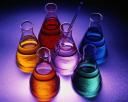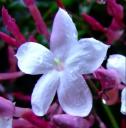Entries Tagged as 'Perfume (Esters)'
History of Perfumes/ Perfume Ingredients/ The Family of Esters/ Formula of Benzyl Acetate/ Properties of Benzyl Acetate/ Uses of Benzyl Acetate/ Benzyl Acetate in Perfumes

They are products of the “esterification” reaction occurring between alcohols and acids. Water is separated as a second product. The reverse reaction is called “hydrolysis.”

Esters have small molecular weight and very nice odor. They are responsible for the pleasant odor of jasmine, roses, etc. and for the odors of apples, bananas, strawberries, etc. The higher the molecular weight, the weaker the odors they carry are.
Unsaturated esters have stronger odor than the saturated ones.
Esters are used in the fragrance and flavoring industries. They also have implication as fixatives and carrier solvents.
1800s -1st fragrances which imitated naturally occurring esters were synthesized in a laboratory.
[Read more →]
Categories: Perfume (Esters)
History of Perfumes/ Perfume Ingredients/ The Family of Esters/ Formula of Benzyl Acetate/ Properties of Benzyl Acetate/ Uses of Benzyl Acetate/ Benzyl Acetate in Perfumes

http://www.youtube.com/watch?v=sqxf7sSVXj8
http://www.youtube.com/watch?v=vVhl0g8t4AY&feature=related
Perfumes have changed from a luxury product to a commodity product. They have become an essential part of people’s lives by representing people’s characters and sending certain messages.
Obtaining synthetic fragrances has developed the perfume industry dramatically and has made it possible for more people to enjoy beautiful and diverse scents.
Benzyl Acetate is one of thousands of esters that can be used for perfume ingredients. It is an extremely significant compound because it provides a basic odor that can be found in many of the perfumes and other cosmetic products.
compound because it provides a basic odor that can be found in many of the perfumes and other cosmetic products.
[Read more →]
Categories: Perfume (Esters)
April 24th, 2008 · Comments Off on Uses of Benzyl Acetate
History of Perfumes/ Perfume Ingredients/ The Family of Esters/ Formula of Benzyl Acetate/ Properties of Benzyl Acetate/ Uses of Benzyl Acetate/ Benzyl Acetate in Perfumes
Since benzyl acetate makes up 40% of the picked jasmine flower, it is widely used in synthetic perfumery. It imparts fruit flavors like those of banana, strawberry, pear and apple and is thus used in the flavoring industry.
Benzyl acetate plays role as a chemical intermediate for the production of other organic compounds. It also acts as a solvent to resins, plastic, polishes, and ink.
The use of benzyl acetate in the US for a year amounts to 1 million kg. There are 33 industrial suppliers of the compound and 75 worldwide.

[Read more →]
Categories: Perfume (Esters)
History of Perfumes/ Perfume Ingredients/ The Family of Esters/ Formula of Benzyl Acetate/ Properties of Benzyl Acetate/ Uses of Benzyl Acetate/ Benzyl Acetate in Perfumes
Physical properties:
Molecular mass: 150.2 g/mol
Odor: sweet floral; fruity; fresh jasmine

- Clear colorless liquid
- Very low solubility in water
- Stable under ordinary conditions
- Found naturally in many flowers
Benzyl acetate is a primary constituent of the essential oils from the flowers jasmine and ylang-ylang. Therefore, it is widely used in perfumery and cosmetics for its aroma and in flavorings to stimulate apple, banana, strawberry, and pear flavors.
In a process not industrially conducted, benzyl acetate is produced by reaction of toluene, acetic acid, and oxygen in the presence of a catalyst.
Acute Health Effects: mild to moderate irritation of skin, eyes, and lungs.
[Read more →]
Categories: Perfume (Esters)
April 24th, 2008 · Comments Off on Formula of Benzyl Acetate
Categories: Perfume (Esters)
History of Perfumes/ Perfume Ingredients/ The Family of Esters/ Formula of Benzyl Acetate/ Properties of Benzyl Acetate/ Uses of Benzyl Acetate/ Benzyl Acetate in Perfumes
Molecules of the fragrance attack the olfactory system, located in the area above the human nose. They attach t receptors, which transmit the signal to the brain via neurons.
Perfumes consist of three layers, or “notes”:
- Top: most volatile, initial smell
- Heart: main aroma of the perfume, some volatility, stays for several hours
- Base: least volatile, stays for most of the day
Basic ingredients:
- 80%-90%: ethyl alcohol
- essential oils from plants
- fruit flavors
Nowadays perfumes consist of 500-600 chemical substances.
Only 5% of today’s perfumes are derived from natural compounds.
Methods for production: expression, distillation, solvent extraction
[Read more →]
Categories: Perfume (Esters)
History of Perfumes/ Perfume Ingredients/ The Family of Esters/ Formula of Benzyl Acetate/ Properties of Benzyl Acetate/ Uses of Benzyl Acetate/ Benzyl Acetate in Perfumes
“The earliest recognizable chemists were women, the perfume-makers of Babylon, who used the earliest known stills to produce their wares. The first individual chemist known to history was “Tapputi, the perfume-maker”, who was mentioned on a cuneiform tablet from the second millennium BCE in Mesopotamia”
~ Paul Strathern, Mendeleev’s Dream
Ancient people realized that there is a pleasure in the aroma of a flower.
People in the area of Indus, Nile and Tigris used herbs and spices for rituals.
The Classical world of Greece and Rome built knowledge of spices, herbs, oils, and developed the process of distillation.
Since perfumes were still a very expensive product, until the 19th century they were used mostly by the wealthiest groups of society.
After WWII the fragrance industry developed greatly with the production of synthetic aromas. These new synthesis increased the variety of scents available and decreased the cost of production, since obtaining odorants from natural sources involves very expensive process.
After 1960 the economies of US, Western Europe, and Japan experienced upward development. Accumulation of disposable income stimulated customer purchases. Now more people could afford luxuries like perfumes. Consequently, perfumes became a personal care product and a common present for family holidays.
Geographical distribution of current sales: Developed world – 80%
32% – USA
26% – Asia Pacific
25% – Western EU
17% – Rest of the World
[Read more →]
Categories: Perfume (Esters)







